Empathy: the Missing Piece of the Collaboration Puzzle
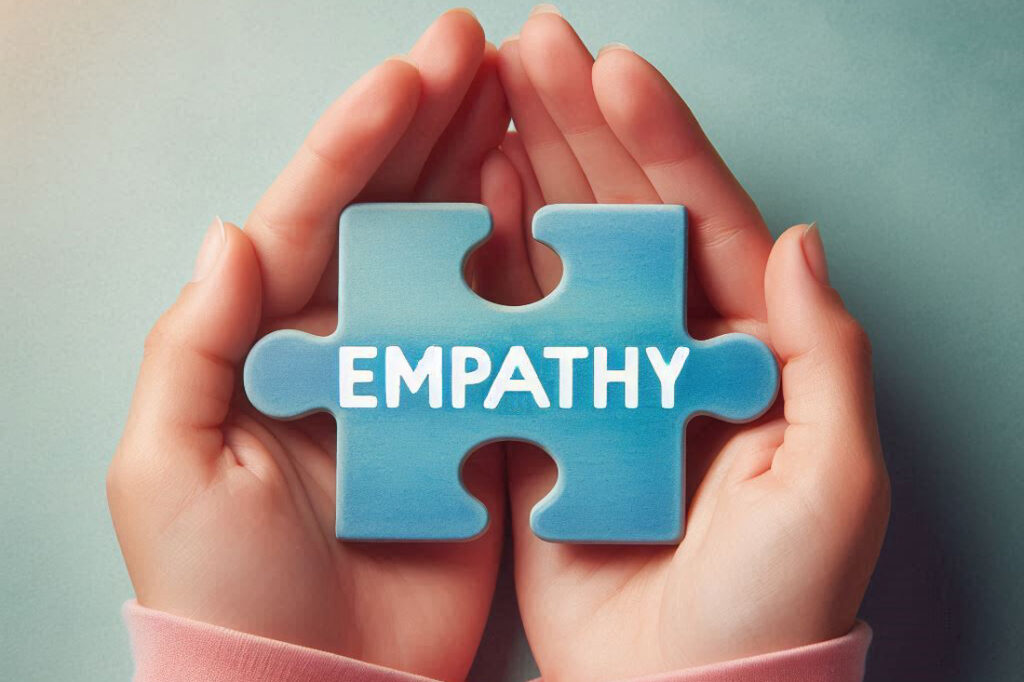
Commercial relationships are struggling, and nowhere is this more true than in collaborative relationships. Such relationships are where Complexity – from both inside and outside the relationship – is highest, and where the fatal flaws in how we typically operate are most clearly (and devastatingly) exposed. Empathy is the missing piece of the puzzle – empathy around the Things That Matter. Why is this so crucial? Why is it missing? And what can we do about it in practice?
Empathy: “the ability to take on another’s perspective… to understand… and respond to their experience”…
We all know the importance of empathy in our interpersonal relationships.
Empathy is also rightly seen as a critical aspect of entrepreneurship, reflecting the crucial insight that Value is principally subjective: the foundation of entrepreneurship is rightly seen as “getting inside” the mind of the customer to understand how they feel, perceive and think.
But what’s also clear – when we shift our focus beyond the interpersonal and individual dimension – is that empathy is lacking in commercial relationships between organizations.
This compromises all organization-to-organization relationships, but especially collaborative ones (whether or not officially designated as such), where the need to work especially closely with each other collides even more dramatically with this deficit of empathy.
In this article, we’ll look at the current state of relationships, we’ll look at the role of Complexity, we’ll look at how failure (of one kind or another) to adequately understand and/or harness it makes things even worse.
We’ll then see how empathy around the Things That Matter is the missing piece of the collaboration puzzle – together with what it looks like to turn this around.
The current state of relationships
Putting it mildly, commercial relationships between organizations are in trouble, which we can put a shape to with our expectations curve:
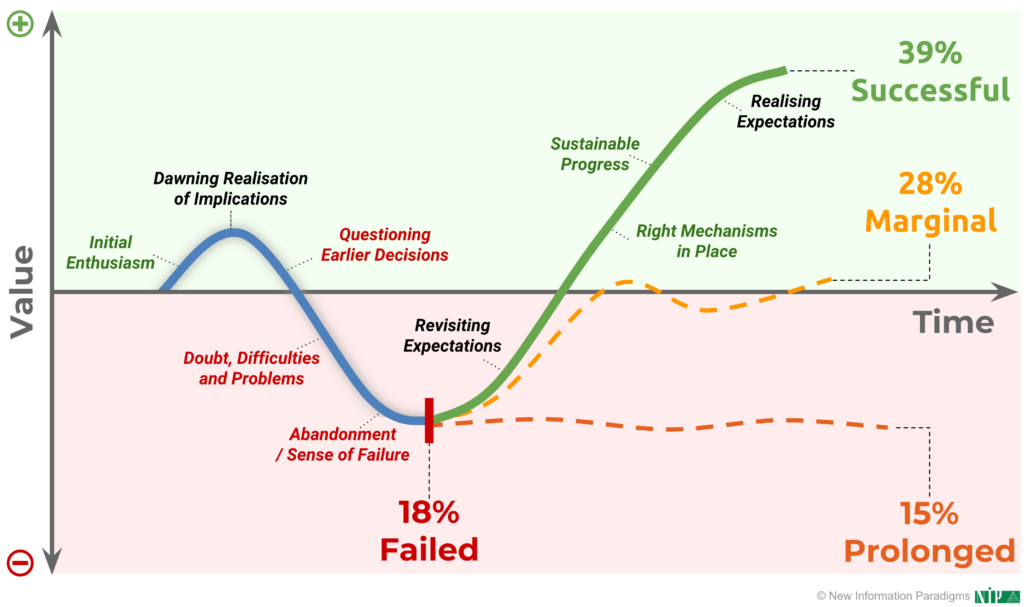
So, issues typically kick in after initial enthusiasm, and it’s then incredibly hard to get things back on track, such that “negative” or neutral outcomes of one kind or another are then far more likely than positive ones – 61% when adding up failure (18%), prolonged issues (15%) and marginal success (28%) vs. 39% for realized expectations.
If anything, front-line feedback suggests that these statistics are conservative – in a poll about this from a recent webinar, for example, not even 30% were familiar with “Fully-realized expectations”; “Prolonged, unresolved issues” were over twice as familiar, and “Relationship failure” was a familiar reality for one in five:
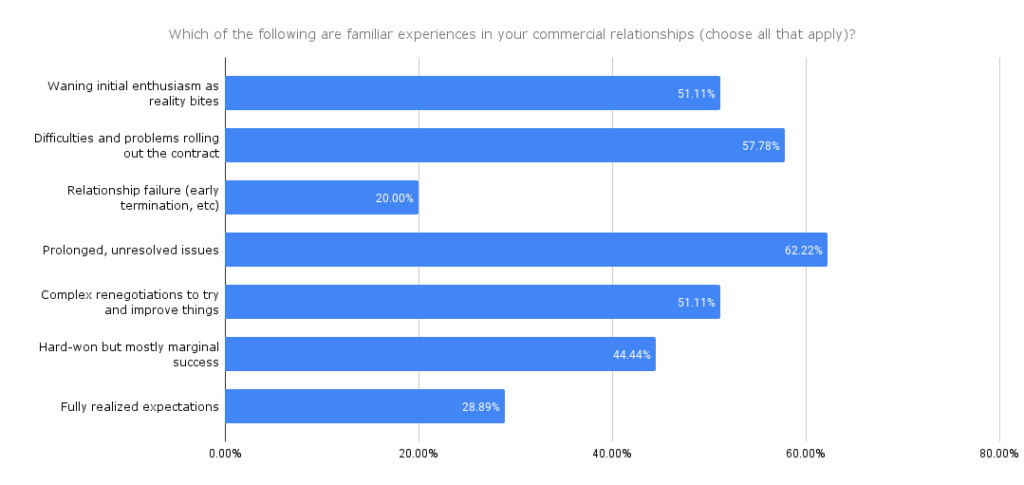
It goes without saying that this comes with unsustainable waste and cost – in both financial and human terms.
But why aren’t relationships working as they need to? Because of two related pressures, the first of which is unprecedented Complexity – the Complexity of reality and of Value.
The challenges of Complexity (including Value)
You may well have seen our world described as “VUCA” – Volatile, Uncertain, Complex and Ambiguous – but Complexity isn’t just one factor of four; it’s the root of all the others – the fundamental nature of reality.
Whilst it’s only a brief overview:
- Complexity starts with lots of interconnected and interacting people and organizations.
- This leads to constant, self-reinforcing change, where the resulting whole is greater than the sum of the inputs – this is called “emergence” in Complexity terms; something new “emerges”.
- The result? Unpredictability, disruption and risk.
So, with “VUCA”, things are volatile, uncertain and ambiguous precisely because of Complexity, and Complexity is also exponential and fractal because people – the root of Complexity – are themselves Complex (such that organizations – by definition – are even more so).
Complexity therefore comes not only from outside relationships – often summarized as PESTLE – but also from within, beginning with the inherent Complexity of people and organizations.
But there’s more.
The Complexity of Value
And that’s because Value – the realization of which is the ultimate purpose of every organization, and of every relationship between organizations – is also a Complex phenomenon.
At the level of the individual, Value emerges from the interactions of internally-held values, experiences, preferences and perspectives – going “beyond” even what could be inferred from a full understanding of each of these factors, even were that possible, which it isn’t:
- Many of these factors are sub-conscious and intuitive, never expressed (or expressible) in definite terms.
- As just explained, emergence introduces novelty and unpredictability.
- In the time taken to achieve this hypothetical understanding, Value would have moved on again.
At the level of the organization, Value then emerges from the Complex interactions of these Complex individuals and each of their Complex conceptions of Value, together with the external complexities of PESTLE and what the end customer values – an exponentially more Complex phenomenon, with even more “emergence” involved.
Collaboration is especially Complex
And this of course helps explain why collaborative relationships are especially Complex:
- They involve closer operation, interaction and integration of Complex people and organizations (such interaction being the foundation of Complexity as we just saw).
- They typically exist to address particularly Complex external challenges (and often particularly Complex end customer needs).
- The Value at stake is higher, and Value – as we’ve just explained – is itself Complex.
So, Complexity is an endemic challenge – it’s the nature of reality and of Value – and it’s heightened in relationships between organizations: especially collaborative ones.
The challenges around how we (typically) operate
Unfortunately, this is all only made worse by how our existing approaches are increasingly not fit for purpose.
For the most part, this is because they’re actively trying to work against Complexity:
- Most organizations work top-down – often called “command and control” – when Complexity means that things are increasingly happening bottom-up.
- We try to pin down and control things when they’re constantly changing and unpredictable.
- Contracts, standards, etc are either too prescriptive – treating unique situations in much the same way – or (and sometimes also) too exhaustive, trying to make sure that nothing gets missed, when it’s of course impossible to do that.
All this means that most organizations tend to focus on what’s objective – especially in what gets measured – when Value is increasingly subjective, so how we’re working isn’t geared towards empathy.
We can represent how we’re currently collaborating with the command and control I’ve just mentioned on the left, and guided and organic – arguably “true” and “authentic” – collaboration on the right:
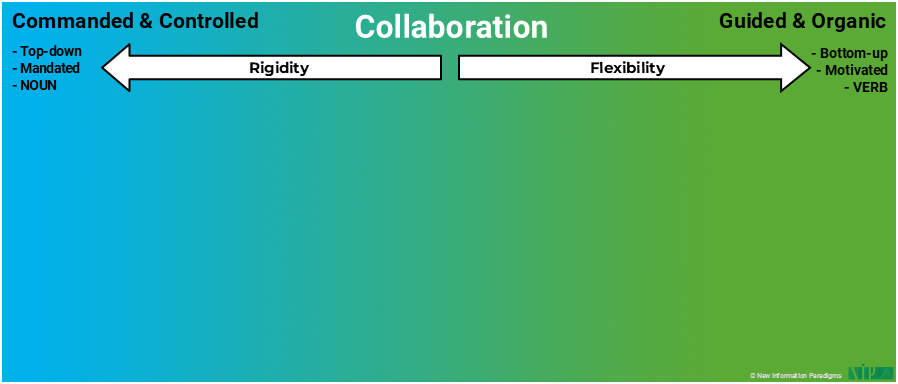
What drives an approach to the left is rigidity: collaboration here is top-down and mandated; in particular, it’s seen as a noun – a static “thing” to define, create, and make happen. It ends-up being bolted-on.
In contrast, what drives an approach to the right is flexibility: collaboration here is bottom-up and more self-motivated; it’s more of a verb -a dynamic adaptable process to encourage and let happen. It becomes baked-in.
Now let’s map on the different ways collaboration can be led (and we’re doing so with how they’re typically used; there are always exceptions):
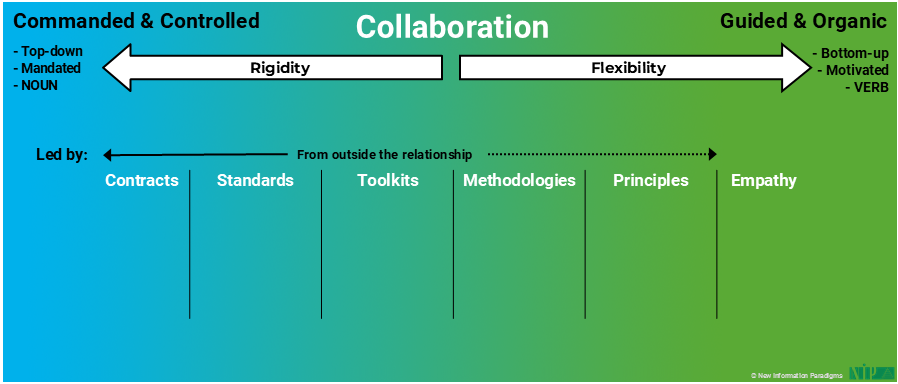
We see that contracts are typically the most top-down, then standards, then toolkits and methodologies – which are usually a bit looser, and with a bit more discretion in how they’re used – followed by principles that guide collaboration and then empathy, which we’ll come back to again shortly.
Then let’s map on the different specific approaches to collaboration (again how they’re typically used) and their relative use and uptake:
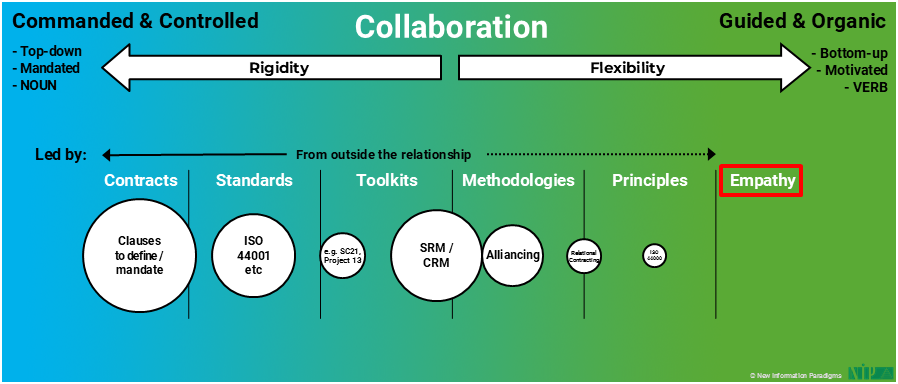
At this point, we see three key things:
- The general picture is clear that more rigid approaches dominate.
- As the L-R arrow above the circles indicates, all the current approaches come to a greater extent (solid line) or lesser extent (dotted line) from outside the relationship: in other words, whilst they may contain great stuff, they’re “sourced” from somewhere else.
- Most of all, there’s a clear gap when it comes to empathy: collaboration “led” from within (and I’ve put inverted commas around “led” because empathy means that collaboration emerges naturally, rather than being directly “led”).
And at this point, even where Value is correctly understood as subjective, and empathy prioritized – I mentioned entrepreneurship above, for example – this is usually seen in terms of the individual.
If organizations are considered at all (much less what happens between organizations), they’re usually implicitly considered as groups of those individuals.
Now, there is obviously an important truth here (an organization isn’t sentient; it can’t itself “value” anything), but this misses the crucial role of emergence we explained above, where something “greater” emerges than the “sum” of what each individual values – something that is also significantly unpredictable (emergent).
And so whichever way we look at it, there’s a gap when it comes to empathy at the organizational level.
The empathy gap
We propose that this empathy gap is what explains the relationship curve we saw above (but which I’ll repeat to save you scrolling):

- In a recent webinar poll, not even 10% were “very confident” that those involved in their commercial relationships were “clear and aligned” on what matters most.
- The majority of the rest were “not too confident” or “not at all confident”.
- WorldCC research suggests that 77% of suppliers question that customers really want to collaborate, with 95% instead seeing price as their main driver.
- Likewise, they’ve found that buyers feel that suppliers care most about revenue and growth, when suppliers say they care about very different things.
So, empathy is clearly lacking, and it’s foundational to how organizations need to work together:
- Empathy means you can properly understand your own perspective and priorities, and then the other party’s.
- Understanding leads to alignment on areas of shared focus and opportunity, alignment on shared challenges, and conscious understanding and management of differences.
- Alignment naturally leads to the emergence of collaboration around agreed objectives and priorities.
- Collaboration then sees the parties acting congruently and starting to deliver results, leading to trust.
- Trust also flows from the associated frankness, directness and transparency throughout.
But empathy isn’t just a “detached” concept or disposition; as we’ve just said, it’s about something – “perspective and priorities” ; your own and the other party’s.
The Things That Matter concept
And this means that empathy is “about” the “Things That Matter” – anything and everything that is valuable and valued; the elements of Value – and the Things That Matter cover:
- Value firstly to the end customer, then to each of the parties in the relationship.
- Value in its widest sense; not just price and cost (so often what conceptions of “value” are mistakenly reductively boiled down to).
- Value creation (towards-the-positive targets, values, etc), avoidance of Value loss (away-from-the negative issues, risks, etc) and conditions around Value (neutral “requirements”, etc, often driven by external factors).
This article explains what a Thing That Matter “looks like” – what it “is” when captured – but for now it’s sufficient to say that Things That Matter are 1. about something, so not entirely detached, and 2. typically broad, so not immediately actionable.
That means they occupy that crucial territory between high-level perception and “on the ground” activity and focus – territory which reflects both the polarity of reality (between “chaos” and “order”) and the structure and operation of our brains.
The Things That Matter are therefore in tune with the most fundamental foundations of empathy – reality and the brain (the literal “source” of empathy) – and by occupying the “middle ground” between abstract and actionable, this makes them the perfect “vehicle” to plug the organizational empathy gap:
- They naturally and effectively capture subjective Value, which is increasingly dominant, involving perceptions and intangibles.
- They provide the appropriate level of abstraction to be immediately recognizable, understandable and relatable – capturing Value in its emergent state – but without jumping straight to “solutions”.
- They enable and focus the inevitable and necessary discussion and “negotiation” around prioritization that comes in with individuals’ differing values, experiences, preferences and perspectives.
- They straddle 1. persistence over time and 2. change, providing the ability to identify change and adapt to it (by refactoring and reprioritizing the Things That Matter).
- They’re both 1. situation-specific and 2. embody recurring patterns (so they reflect uniqueness, but learning can be captured and judiciously shared for discerning individuals to use as appropriate).
The Things That Matter are therefore the ideal proxy for Value – they represent it – so they quickly get to the heart of the matter, without having to define what the nature of Value is or isn’t (and whilst we can’t emphasize enough that Value is primarily subjective, the point is that this debate can be sidestepped where it would be a distraction).
After all, “Things That Matter” is a common and compelling phrase that’s easily understood and acted upon:
- Everyone has a view on the things that are important and relevant in particular situations and circumstances.
- Who wants to be focused on what doesn’t matter?
- The phrase taps into fundamental neural pathways (since our earliest memories, we’ve been asked “what’s the matter?” and we know the power of asking that question of others).
- “Things That Matter” engage and motivate everybody involved (this article covers in more depth how and why the concept is entirely inclusive, most especially as a whole phrase, which makes the use of “things” far from reductionist and nominalizing).
With our analogy of empathy being the missing piece of the collaboration puzzle, the Things That Matter concept therefore provides the content of that piece.
But at this point we need to look again at our definition of empathy – “the ability to take on another’s perspective… to understand… and respond to their experience” – as we see that it’s an ability.
That means empathy is not just about content, and neither is it passive; it doesn’t just happen – it needs to be actively focused-on, it may not come naturally, and it’s something we need to develop and can get better at.
So if the content of empathy is the Things That Matter, what is the process? What shapes this missing piece of the puzzle and makes it “fit”?
The Things That Matter process
What shapes empathy to make it “fit”… is our Three Step Process: an iterative process absolutely built on and around empathy to operationalize it around the Things That Matter:
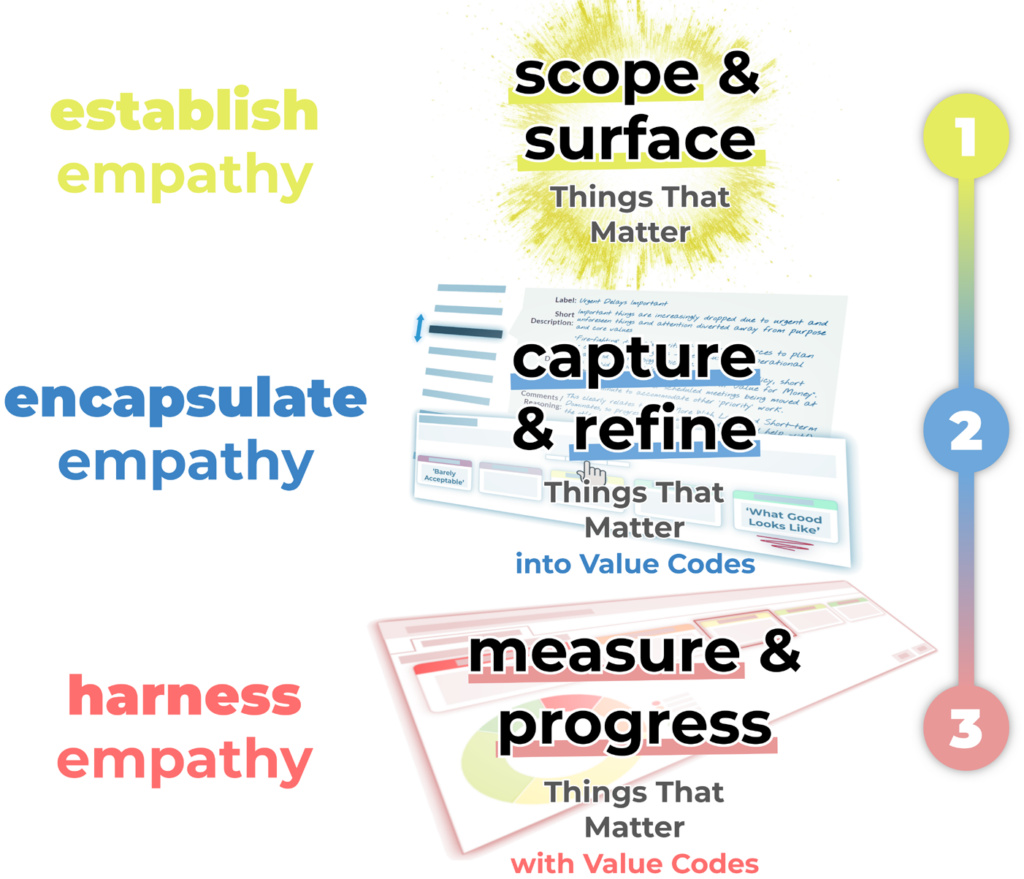
- Step one establishes empathy, by surfacing Things That Matter to each party and then to both parties.
- Step two encapsulates that established empathy, by capturing and then making those Things That Matter measurable – a process we call “Value Coding”.
- Step three harnesses the power of that established and encapsulated empathy by measuring and making improvements with the Things That Matter – the Value – in the relationship.
All of these steps are explained in more depth elsewhere on this site – in particular what’s involved in surfacing Things That Matter, in developing Value Codes, and in deploying those Value Codes at scale in Diagnostics – but the key point here is that there is a process.
This process accompanies the concept of Things That Matter, and makes it possible to effectively and productively engage people at scale:
- Harnessing the very dynamic of interaction that drives Complexity to responding appropriately to it, by working with and capturing bottom-up emergence.
- Similarly, through Diagnostics (and, where appropriate, Large Language Models), using the technology that accelerates Complexity to power and support this response.
- Providing a “generative constraint” by giving a meta-structure of what needs to be done – reflecting the need for appropriate “order” (therefore providing a “constraint“) – without in any way predetermining the content of what matters, and instead facilitating its emergence (“generative”).
- Supporting the crucial “journey” from perceptual, primarily subjective and high-level to actionable, objectively-described and relevant detail.
And so, returning to our “missing piece of the collaboration puzzle” analogy, the Things That Matter process therefore provides the shape of that piece. This is how that piece fits in:

Looking “left” to “right”, it will help identify what matters in what’s already in place and contribute to the building of empathy.
Achieve empathy and – “right” to “left” – it will also complement and help harness the undoubted value in the other approaches on the collaboration spectrum, pointing to exactly how and when to do so.
After all, methodologies and things like relational contracting (the second circle in from the right if the text is too hard to make out) are often brought in as “the answer” before the problems they’re looking to help with – and how they can help with those problems – are clear to people, so there’s pushback.
With empathy operationalized, though, it’s possible to really target the relevant parts of whatever you want to bring in, and it’s clear that the actions taken are directly related to the agreed Things That Matter: you can show your working.
So, are you ready to start addressing the empathy gap and put in place the missing piece of the collaboration puzzle by surfacing, aligning around and relentlessly focusing on the Things That Matter? What are you waiting for?

